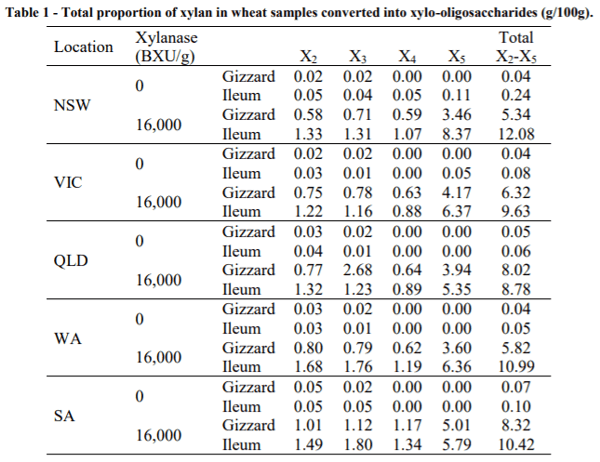In Vitro Evaluation of Xylo-Oligosaccharide Production from Different Batches of Wheat with and without Xylanase
Published: June 15, 2021
By: N.K. MORGAN 1, M. CHOCT 1, A. WALLACE 1, K.L. HAWKING 1, S.B. WU 1 and M.R. BEDFORD 2 / 1 University of New England, 2351 Australia; 2 AB Vista, Marlborough, Wiltshire SN8 4AN, UK.
Supplementing poultry diets with xylanase partially depolymerizes the xylans present in the dietary cereals, reducing the number of sugars in the molecular chains. The resulting oligosaccharides can be selectively fermented by beneficial intestinal bacteria, resulting in improved nutrient utilization (De Maesschalck et al., 2015). The study aim was to investigate the production of xylo-oligosaccharides (XOS) in different batches of Australian wheat, in the presence or absence of xylanase. Five different batches of wheat were selected from NSW, VIC, QLD, WA and SA. Samples were exposed to a 2-step in vitro digestion assay that simulated gastric (pH 3.5 with 0.1M HCl and pepsin) and small intestine (pH 6 with 1M NaOH and pancreatin) phases of digestion in broiler chickens. Either 0 or 16,000 BXU/g xylanase (Econase XT 25, AB Vista Feed Ingredients, UK) was added. The samples were centrifuged and resulting supernatant prepared for analysis of XOS composition, along with standards of xylobiose (X2), xylotriose (X3), xylotetraose (X4) and xylopentaose (X5) (Morgan et al., 2018). The standards and samples were analysed on a Shimadzu LCMS-8050 with a C18 HPLC column by electrospray ionization.
Xylanase inclusion diversely impacted XOS production across the wheat varieties (Table 1), demonstrating how growth conditions impact their susceptibility to degradation in the gastrointestinal tract environment, and where in the tract the majority of XOS production occurs. The greatest abundance of XOS was produced from wheat from NSW, wheat from QLD seemed to be degraded substantially during the gizzard phase but no further in the ileal, and wheat from WA produced the most X2 and X3. This study highlights a new and important facet of cereal NSP content and highlights the need to focus xylanase research on determining the optimal XOS production rate and location to generate the best prebiotic effects in wheat based diets.

Abstract presented at the 30th Annual Australian Poultry Science Symposium 2019. For information on the latest edition and future events, check out https://www.apss2021.com.au/.
References
Morgan N, Keerqin C, Wallace A, Wu S-B & Choct M (2018) Animal Nutrition (in press) https://doi.org/10.1016/j.aninu.2018.05.001
De Maesschalck CD, Eeckhaut V, Maertens L, De Lange L, Marchal L, Nezer C, De Baere S, Croubels S, Daube G, Dewulf J, Hasebrouck F, Ducatelle R, Taminau B & Immerseel, FV (2015) Appl. Environ. Microbiol. 81: 5880-5888.
Related topics:
Authors:
University of New England
University of New England
University of New England
AB Vista
Show more
Recommend
Comment
Share
Universidad ISA (Instituto Superior de Agricultura)
25 de julio de 2021
Dr Mingan what are the benefits of xylanase in a soy-corn diet in broilers?
Kind regards from the Dominican Republic
Recommend
Reply

Would you like to discuss another topic? Create a new post to engage with experts in the community.











.jpg&w=3840&q=75)